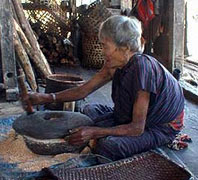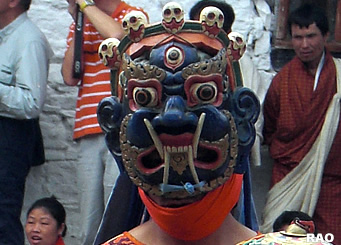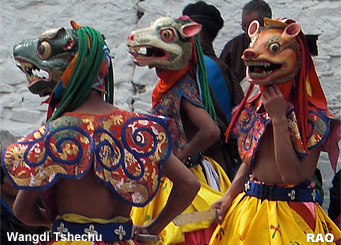 |
Bhutan's
Festivals Tshechu |
 |
Bhutan Information |
|
|
 |
|
Tshechus:
Losing significance?
|
 |
 |
| The
lack of interest among the youth in the tshechu was a cause of concern
for many elders attending the three-day Wangduephodrang tshechu.
"The youth prefer to be at the fair rather than
watch the tshechu," said Phurba, a 75 year-old man from Rinchengang.
"I do not understand why." A fair had been put up by locals and people
from other dzongkhags. It included food and gambling stalls and video screenings
of local movies which is always a big draw. |
|
Bjena
gup Dechen said that elders at home attended the tshechu leaving important
work at home unattended. "They understand the meaning and importance of
the tshechu," he said. "Obstacles and ill fortune
will be removed in this life if we attend the tshechu," he said.
The fair although organised for the people was a big distraction to the
tshechu, he added. "The youth go out of the house saying they want to attend
the tshechu but they end up spending their time at the fair."
 |
| A
former Rinchenling shedra teacher, Kinley, said that the youth should
be made aware of the significance of the tshechu. "Schools
should have books about tshechus," he said. "The media should
also play a part by giving information about the tshechu before it starts."
He added that going by present trends, the Bhutanese youth could get themselves
disconnected from their own culture and tradition and later even fail to
identify themselves as Bhutanese. "Their ignorance
about the tshechu is a sign of eroding cultural values," said
Kinley. |
|
The
mask dances performed by the monks of the Dorling Raksha kuencham drew the biggest crowd as the masks worn during this cham were said to
be the treasures retrieved by a terton. Amid the riot of colours of brocade
tegos, intricate hand woven kiras and multicoloured ghos, Angay (grandma)
Namgay Dem sits with four grandchildren. "They tag along with me wherever
I go," she says.
Angay
Namgay Dem, 66, lives in Punakha and has come to Thimphu to watch the
tshechu. "I tell my grandchildren the importance
and significance of the tshechu just like my grandparents had taught and
explained it to me when I was a child," she says. Urbanisation
and a changing lifetsyle has had an impact. "The dress that the mask dancers
wear are more sophisticated and rich, and traditional dances are more light
and lively," says Angay Namgay Dem. "There are also more people attending
the tshechu now and they all seem better dressed," she adds. "But I am
not sure about their faith and understanding of the tshechu."
A
look around the courtyard shows mostly elderly citizens and young children
apart from elderly tourists. There are young families and families
of security personnel. Most are from a rural background. The more slick
sophisticated educated urbanised Thimphu crowd is conspiciously absent.
Most are doing other things than attending the tshechu.
For
the urbanised Thimphu crowd, the tshechu means holidays to do other things,
like going out of town, going on picnics and parties and polishing up on
a game of golf. Attending the tshechu is not quite on the agenda, may be
on the last day to get blessings and for the shortest time possible.
"I
attend the tshechu as it is a great photo opportunity," says a Bhutanese
architect. He agrees that urbanised Thimphu residents hardly ever attend
the tshechu. "I have never met any of my friends at the tshechu in the
last four to five years." There were some who thought the dances were long
and tedious to watch. But some pointed out that the Tashichhodzong courtyard
was too small to accommodate everyone interested in attending the tshechu.
If you get in late chances are that you will not get to see the dances
because it is very crowded.
For
several young people the tshechu is a time "for
gaining merit and at the same time an opportunity to be with family and
friends and meet new people," said Pema a junior high school
student who had come along with his friends. "It
is education on the good and the bad."
During
the break around midday, families sit in groups and relish the food brought
from home. "When we die, we meet the characters that we see during the
tshechu and if we do not recognise them we will see them in a state of
anger and fury," says a girl studying in the seventh standard. "My
mother told me this and since then the tshechus have meant something different."
Sonam
Jamtsho, a 27 year old working in a private firm can't help laughing during
the performance of the Pholay and Molay dance/scene. "Some
of the movements are quite base but it teaches people about the good and
bad that exists in a society," he says.
The
intrigued youth are uncertain about the whole concept of gaining merit
from attending the tshechu while the elders are devoted and sure of it.
The minors just tag along excited to be in the crowd.
"Maybe
it has something to do with age," said Phuntsho, a corporate employee who has not attended tshechu for some years now. "As we get older then
maybe we start getting devoted and think it is important to attend it."
Some
of the dances that were performed were dance of
the 21 black hats, dance of the ladies and noblemen, dance of the lords
of the cremation grounds, dance of the Rakshas, dance of the eight manifestations
of Guru Rinpoche and the dance of the judgement of the dead.
 |
| By
Kinley Wangmo, KUENSEL, Bhutan's National Newspaper |
| Information on Bhutan |
 |
 |
|
Wangdidzong,
Wangduephodrang |
|








